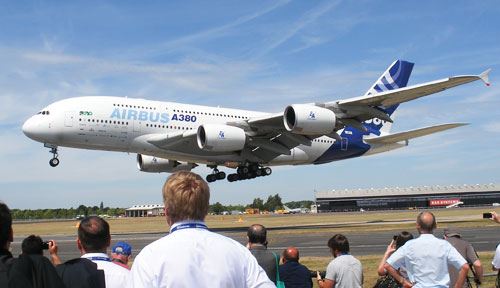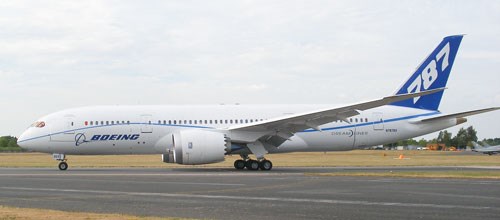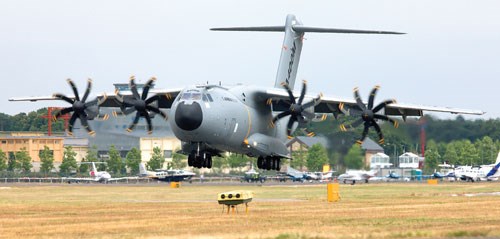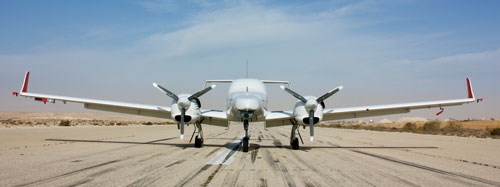Farnborough International Airshow 2010
Although uncertainties remain, aircraft OEMs see recovery in order numbers.
Not quite as impressive as 2008’s boom-year event, the 2010 edition of the biennial Farnborough International Airshow (July 19-25) nevertheless hosted 1,450 exhibitors, 57 more than in 2008, and 280,000 attendees, says event organizer Farnborough International Ltd. (Farnborough, North Hampshire, U.K.). Although considerable buzz was generated by the international debut of The Boeing Co.’s (Chicago, Ill.) Dreamliner and appearances of other aircraft that have dominated aviation news (see photos, this page), the big news was that the huge trade fair attracted buyers from 44 countries who placed orders totaling a postrecession-respectable $47 billion (USD) — no match for 2008’s $88.7 billion but on par with 2006, at $46 billion.
Aircraft sales: Hot (and not)
Boeing Commercial Airplanes president/CEO Jim Albaugh explained in his press briefing that despite some continued uncertainties, Boeing’s view of the commercial aircraft market is increasingly positive as the world regains its economic footing. The market is “clearly” coming back, he claimed, citing more than 3,304 unfilled orders for Boeing aircraft as of June 30. For single-aisle aircraft, Albaugh said, “Boeing will set a strategic direction with respect to further developing the 737 and new airplane designs within a few months. Our decision will be determined by the best way to meet the future needs of our customers.”
On the show’s first day, events underscored Boeing’s confidence. GE Capital Aviation Services (Stamford, Conn.) placed a $3 billion order for 40 next-generation 737-800 jets. An order for 15 more came from Norwegian Air Shuttle ASA (Fornebu, Norway). Beijing, China-based Okay Airways followed with an order for 10 — its first-ever Boeing purchase.
Boeing also announced its new ecoDemonstrator program, a platform that will integrate new technologies for reducing fuel consumption and aircraft noise. Helped by a $25 million matching-fund award from the U.S. Federal Aviation Admin., Boeing plans to field advanced engines with composite components, adaptive wing trailing-edge flaps, fuel cell technology and other innovations on a next-generation 737 in 2012 and a twin-aisle aircraft in 2013.
Airbus (Toulouse, France) affirmed its confidence in the airline industry’s comeback, with 133 firm orders and 122 commitments booked at the show (reportedly worth $28 billion) in addition to Emirates Airline’s (Dubai, U.A.E.) order for 32 additional A380 aircraft announced in June. “The recession is definitely over,” declared John Leahy, Airbus’ chief operating officer, citing renewed liquidity in the marketplace, increased air traffic and gross domestic product (GDP) growth as factors in “strong growth.”
As Airbus and Boeing basked in the new-orders glow, Bombardier (Montreal, Quebec, Canada), an aspiring competitor in the 100- to 149-passenger commercial aircraft niche, reportedly came away from Farnborough without a single new order for its composites-intensive CSeries jet. Preshow expectations were high: Bombardier had collected 90 firm orders and an equal number of options, and had reported ongoing conversations with 11 airlines. Various media reports focused blame on the plane’s shorter-than-common range (2,200 nautical miles) and its engines. Bombardier did not come up empty-handed, however. Orders for 16 business jets came through in the week preceding the event and during show week, valued at ~$800 million USD.
The ever-expanding UAV market
Also in the spotlight were unmanned aerial vehicles (UAVs) of all types and sizes. Notable among them was Turkish Aerospace Industries’ (Ankara, Turkey) new “operative-class” medium-altitude, long-endurance (MALE) UAV. Dubbed ANKA, the craft was unveiled in Ankara a few days prior to the show and showcased at a Farnborough press event. Its 56-ft/17m wingspan is similar to that of General Atomics’ (San Diego, Calif.) Predator and its airframe design likewise incorporates composites.
Boeing announced a memorandum of understanding with Aeronautics Ltd. (Yavne, Israel) to market the Dominator (see photo, at right), a UAV adaptation of a piloted Diamond Aircraft (London, Ontario, Canada) all-composite twin-engine DA42. According to Boeing’s Chris Chadwick, president of Boeing Military Aircraft (St. Louis, Mo.), the MALE segment of the UAV market is expanding rapidly.
Aircraft composites contracts
GKN Aerospace (Redditch, Worcester, U.K.) revealed that it had won contracts to develop and produce all the composite components for the inboard and outboard landing flaps of the Airbus A350 XWB. The first components for developmental flaps will be delivered early in 2011. GKN Aerospace already has production composite-assemblies contracts for the rear spar and fixed trailing edge on the plane’s wings.
Among the composite material suppliers at the show, Advanced Composites Group Ltd. (ACG, Heanor, Derbyshire, U.K.) exhibited its epoxy, bismaleimide and phenolic prepregs for civil aircraft interiors and structural components. ACG highlighted its status as a qualified epoxy prepreg supplier to Elbit Systems (Haifa, Israel), the manufacturer of the Watchkeeper 450 UAV on display at the Thales Group (Neuilly-sur-Seine, France) stand. ACG’s MTM46 out-of-autoclave prepreg permits fabrication on lower-cost tooling while producing parts that are still capable of achieving the performance specifications. EAST-4D Carbon Technology GmbH (Dresden, Germany) showcased its expertise in carbon composite components for aviation and other markets via filament winding and resin transfer molding.
Related Content
From the CW Archives: Airbus A400M cargo door
The inaugural CW From the Archives revisits Sara Black’s 2007 story on out-of-autoclave infusion used to fabricate the massive composite upper cargo door for the Airbus A400M military airlifter.
Read MoreBladder-assisted compression molding derivative produces complex, autoclave-quality automotive parts
HP Composites’ AirPower technology enables high-rate CFRP roof production with 50% energy savings for the Maserati MC20.
Read MoreCompPair adds swift prepreg line to HealTech Standard product family
The HealTech Standard product family from CompPair has been expanded with the addition of CS02, a swift prepreg line.
Read MorePlant tour: Albany Engineered Composites, Rochester, N.H., U.S.
Efficient, high-quality, well-controlled composites manufacturing at volume is the mantra for this 3D weaving specialist.
Read MoreRead Next
EAA AirVenture 2010
Rain on the Wittman Field runways can’t dampen Oshkosh Fly-In enthusiasm.
Read More“Structured air” TPS safeguards composite structures
Powered by an 85% air/15% pure polyimide aerogel, Blueshift’s novel material system protects structures during transient thermal events from -200°C to beyond 2400°C for rockets, battery boxes and more.
Read MoreAll-recycled, needle-punched nonwoven CFRP slashes carbon footprint of Formula 2 seat
Dallara and Tenowo collaborate to produce a race-ready Formula 2 seat using recycled carbon fiber, reducing CO2 emissions by 97.5% compared to virgin materials.
Read More


























